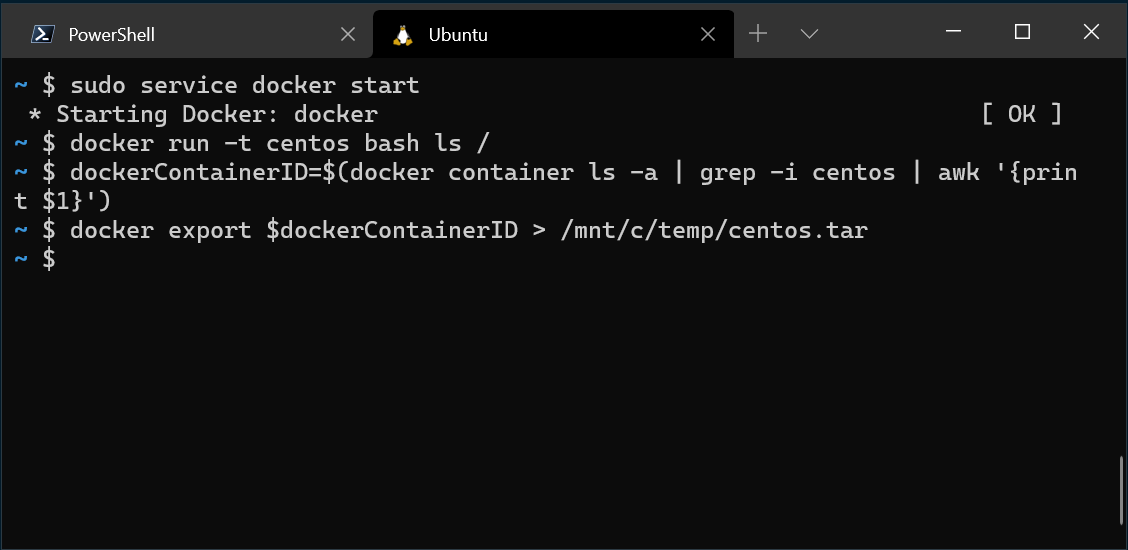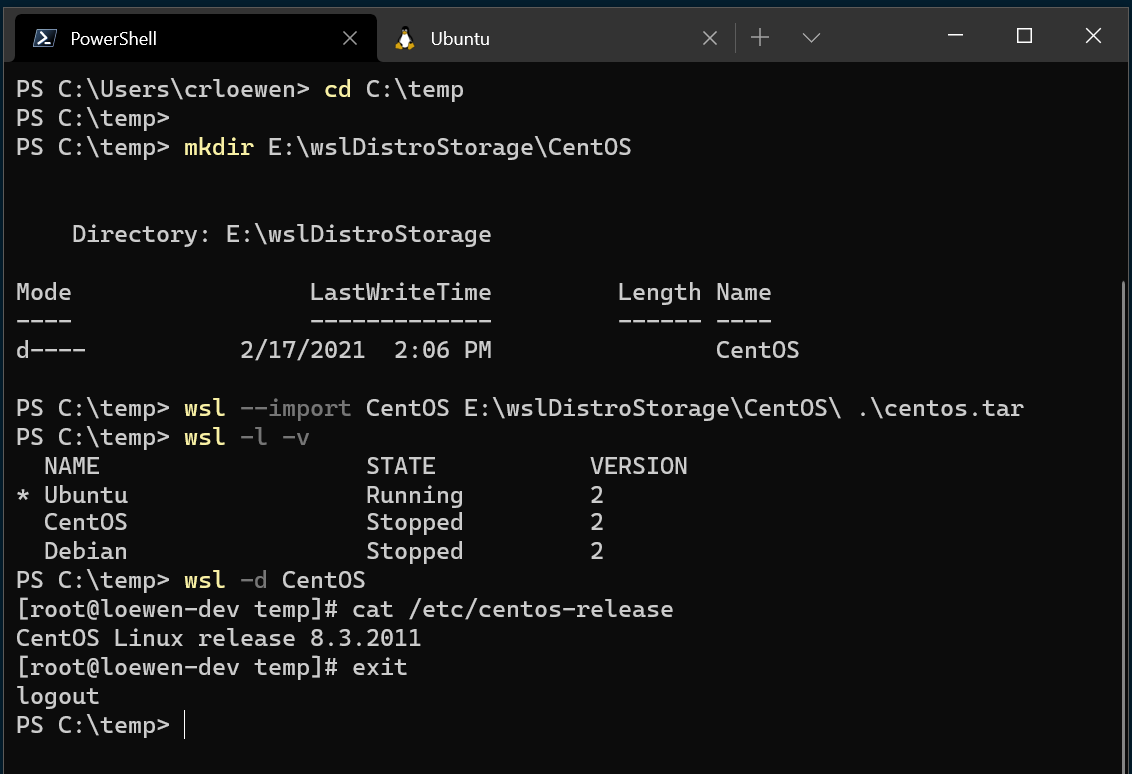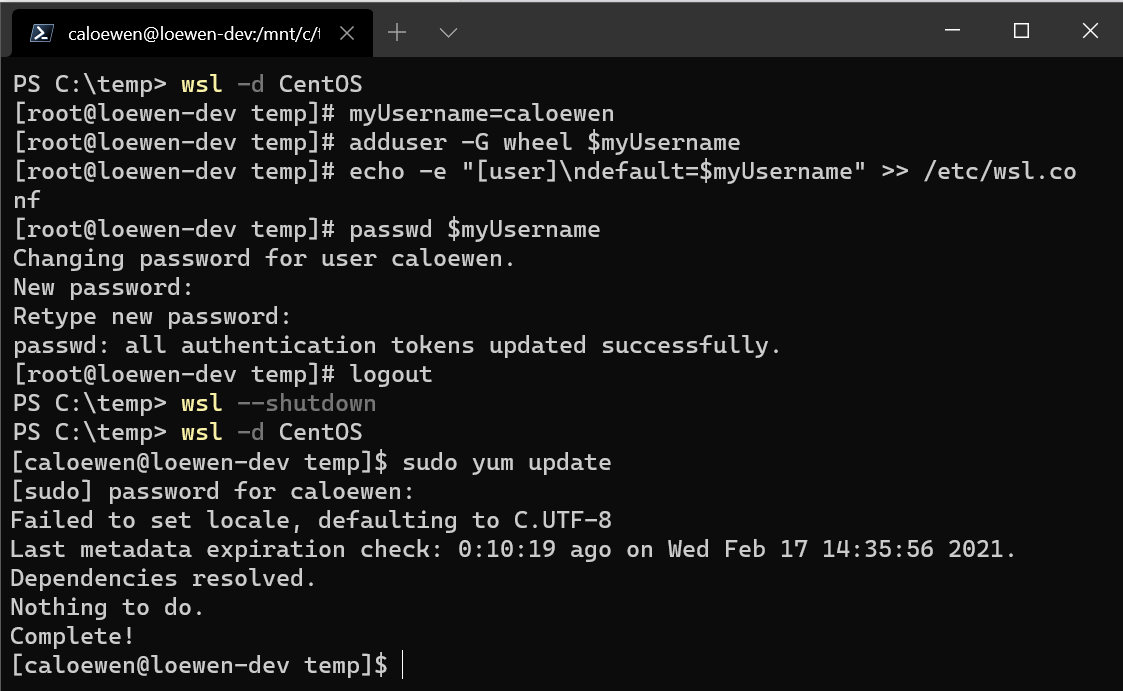Nuta
Dostęp do tej strony wymaga autoryzacji. Możesz spróbować się zalogować lub zmienić katalog.
Dostęp do tej strony wymaga autoryzacji. Możesz spróbować zmienić katalogi.
Można użyć dowolnej dystrybucji systemu Linux wewnątrz podsystemu Windows dla systemu Linux (WSL), nawet jeśli nie jest dostępny w Sklepie Microsoft Store, importując go z plikiem tar.
W tym artykule pokazano, jak zaimportować dystrybucję systemu Linux CentOS do użycia z usługą WSL, uzyskując plik tar przy użyciu kontenera platformy Docker. Ten proces można zastosować do importowania dowolnej dystrybucji systemu Linux.
Uzyskiwanie pliku tar dla dystrybucji
Najpierw należy uzyskać plik tar zawierający wszystkie pliki binarne systemu Linux dla dystrybucji.
Plik tar można uzyskać na różne sposoby, z których dwa obejmują:
- Pobierz podany plik tar. Przykład alpine można znaleźć w sekcji "Mini Root Filesystem" witryny Alpine Linux do pobrania .
- Znajdź kontener dystrybucji systemu Linux i wyeksportuj wystąpienie jako plik tar. W poniższym przykładzie pokazano ten proces przy użyciu kontenera CentOS.
Uzyskiwanie pliku tar dla przykładu systemu CentOS
W tym przykładzie użyjemy platformy Docker wewnątrz dystrybucji WSL, aby uzyskać plik tar dla systemu CentOS.
Wymagania wstępne
- Musisz mieć włączony WSL z zainstalowaną dystrybucją systemu Linux działającą na WSL 2.
- Musisz mieć zainstalowany program Docker Desktop dla systemu Windows z włączonym silnikiem WSL 2 i zaznaczoną integracją Zobacz umowę licencyjną programu Docker Desktop, aby uzyskać aktualizacje warunków użytkowania.
Eksportowanie tar z kontenera
Otwórz wiersz polecenia (Bash) dla dystrybucji systemu Linux, która została już zainstalowana ze sklepu Microsoft Store (ubuntu w tym przykładzie).
Upewnij się, że masz uruchomiony program Docker Desktop (lub jeśli platforma Docker jest zainstalowana w dystrybucji WSL, uruchom usługę
sudo service docker startza pomocą polecenia )Uruchom kontener CentOS wewnątrz platformy Docker:
docker run -t --name wsl_export centos ls /Wyeksportuj identyfikator kontenera do pliku tar na zainstalowanym dysku c-drive:
docker export wsl_export > /mnt/c/temp/centos.tar
Czyszczenie kontenera
docker rm wsl_export
Ten proces eksportuje plik tar CentOS z kontenera platformy Docker, aby można było go teraz zaimportować do użytku lokalnego z usługą WSL.
Importowanie pliku tar do programu WSL
Po uzyskaniu gotowego pliku tar możesz go zaimportować przy użyciu polecenia :
wsl.exe --import <Distro> <InstallLocation> <FileName> [Options]
Options:
--version <Version>
--vhd
Przykład importowania systemu CentOS
Aby zaimportować plik tar dystrybucji CentOS do programu WSL:
Otwórz program PowerShell i upewnij się, że masz folder, w którym chcesz przechowywać dystrybucję.
cd C:\temp mkdir E:\wslDistroStorage\CentOSZa pomocą polecenia
wsl --import <Distro> <InstallLocation> <FileName>zaimportuj plik tar.wsl --import CentOS E:\wslDistroStorage\CentOS .\centos.tarUżyj polecenia
wsl -l -v, aby sprawdzić, które dystrybucje zostały zainstalowane.Na koniec użyj polecenia
wsl -d CentOS, aby uruchomić nowo zaimportowaną dystrybucję systemu CentOS Linux.
Dodawanie składników specyficznych dla protokołu WSL, takich jak użytkownik domyślny
Domyślnie w przypadku korzystania z programu --importużytkownik główny jest zawsze uruchamiany jako użytkownik główny. Możesz skonfigurować własne konto użytkownika, ale należy pamiętać, że proces konfigurowania będzie się nieznacznie różnić w zależności od poszczególnych dystrybucji systemu Linux.
Aby skonfigurować konto użytkownika z właśnie zaimportowaną dystrybucją CentOS, najpierw otwórz program PowerShell i uruchom go w systemie CentOS, używając polecenia :
wsl -d CentOS
Następnie otwórz wiersz polecenia CentOS. Użyj tego polecenia, aby zainstalować narzędzia do ustawiania ustawień sudo i hasła w systemie CentOS, utworzyć konto użytkownika i ustawić je jako domyślnego użytkownika. W tym przykładzie nazwa użytkownika będzie mieć wartość "caloewen".
Uwaga / Notatka
Należy dodać nazwę użytkownika do pliku sudoers, aby umożliwić użytkownikowi korzystanie z programu sudo. Polecenie adduser -G wheel $myUsername dodaje użytkownika myUsername do grupy wheel. Użytkownicy w grupie koła mają automatycznie przyznane uprawnienia sudo i mogą wykonywać zadania wymagające uprawnień z podwyższonym poziomem uprawnień.
yum update -y && yum install passwd sudo -y
myUsername=caloewen
adduser -G wheel $myUsername
echo -e "[user]\ndefault=$myUsername" >> /etc/wsl.conf
passwd $myUsername
Musisz teraz zamknąć tę instancję i upewnić się, że wszystkie instancje WSL są zakończone. Uruchom ponownie dystrybucję, aby zobaczyć nowego użytkownika domyślnego, uruchamiając to polecenie w programie PowerShell:
wsl --terminate CentOS
wsl -d CentOS
Teraz zobaczysz [caloewen@loewen-dev]$ jako wynik na podstawie tego przykładu.

Aby dowiedzieć się więcej na temat konfigurowania ustawień programu WSL, zobacz Konfigurowanie ustawień za pomocą pliku .wslconfig i wsl.conf.
Używanie niestandardowej dystrybucji systemu Linux
Możesz utworzyć własną dostosowaną dystrybucję systemu Linux opakowaną jako aplikację w modelu UWP, która będzie działać tak samo jak dystrybucje WSL dostępne w Sklepie Microsoft Store. Aby dowiedzieć się, jak to zrobić, zobacz Tworzenie niestandardowej dystrybucji systemu Linux dla systemu WSL.
Windows Subsystem for Linux